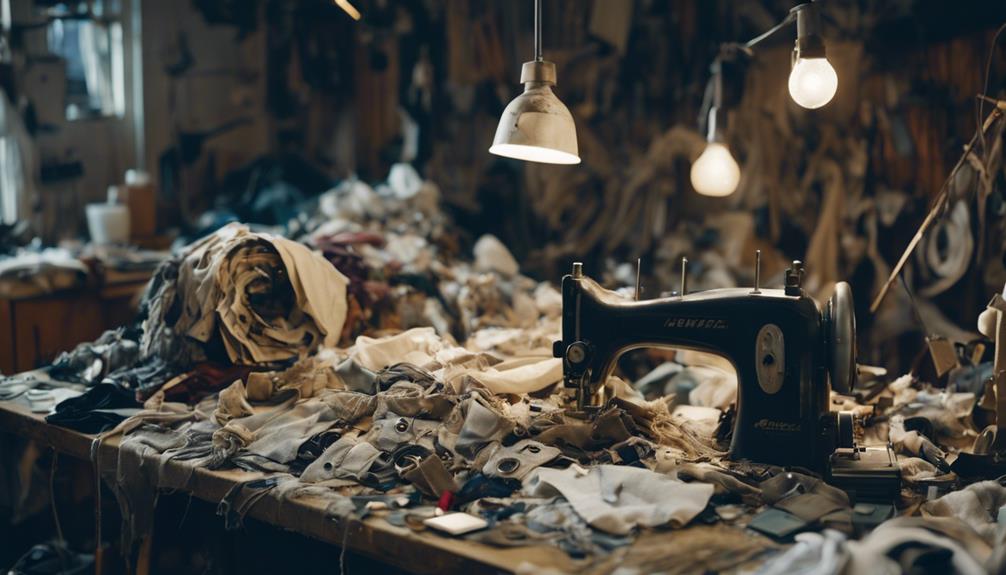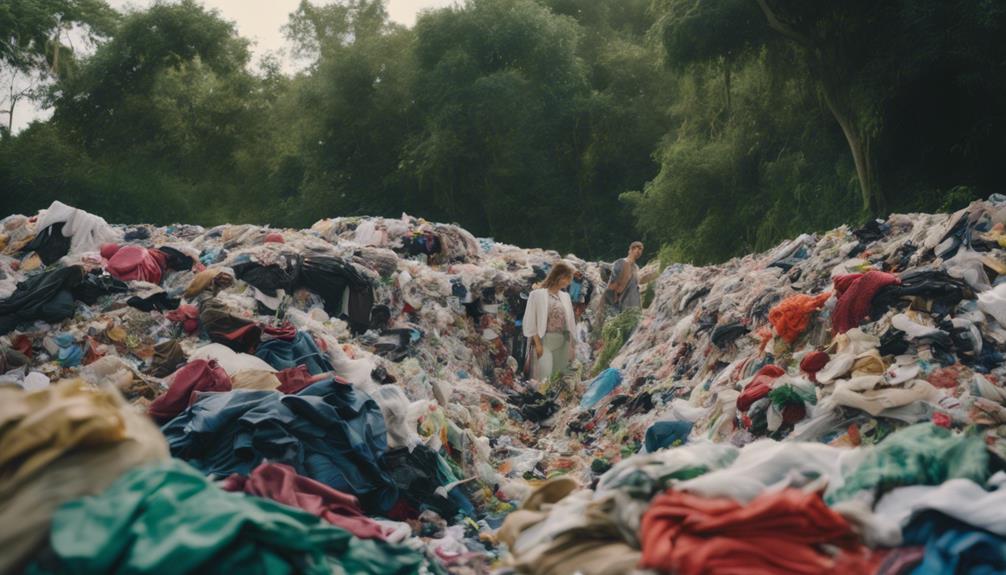Sustainable fashion may sound appealing, however the truth is quite alarming. Many brands’ claims of sustainability are not fully realized. In reality, 85% of textiles end up in landfills each year. While recycling innovations are available, they often only make things slightly “less unsustainable” rather than truly sustainable. Consumer behavior further complicates matters; despite a desire for ethical options, many still support fast fashion. The industry truly requires systemic change and regulatory pressure in order to make significant improvements. If you are interested in learning more about the specific challenges and potential solutions, there is more to explore.
Key Takeaways
- The fashion industry's sustainability claims often mislead consumers, as 85% of textiles still end up in landfills annually.
- Innovations like recycling and rental schemes are often 'less unsustainable' rather than genuinely effective in reducing environmental impact.
- True sustainability requires systemic changes, not just surface-level improvements, to address the industry's major environmental challenges.
- Consumer awareness is crucial; despite intentions, many continue supporting fast fashion, undermining sustainability efforts.
Industry Claims Vs. Reality
When you plunge into the fashion industry's claims of sustainability, you'll quickly find that the reality often falls short of the promises made. The environmental impact of the fashion industry has barely budged over the past 25 years, with most products still made from non-biodegradable, petroleum-based materials.
You might see labels touting sustainable fashion, but many of these so-called innovations, like recycling and bio-based materials, are just 'less unsustainable' options rather than true sustainability. Around 85% of textiles produced each year end up in landfills, which underscores how ineffective current business models are in tackling waste and pollution.
While high-profile companies may promote carbon-positive and organic items, they often fail to address the core issues at hand. As the fashion industry continues to grapple with its environmental impact, there's an increasing call for regulatory intervention to hold companies accountable.
Market-based solutions haven't resolved sustainability challenges, leaving consumers like you questioning what really constitutes sustainable fashion. Understanding these discrepancies is vital as you navigate your choices in a world that desperately needs genuine, effective change.
Failed Innovations in Fashion

Despite the buzz around innovative approaches in sustainable fashion, many of these efforts have proven ineffective in making a real impact on the industry's environmental footprint. Failed innovations like bio-based materials and various recycling initiatives often fall short, failing to address the root causes of environmental degradation. You might think that concepts like rental services would curb the fast fashion cycle, but they haven't delivered meaningful results either.
Many current business models focus on recycling, resale, and rental, yet they often ignore the vital issue of reliance on non-biodegradable, petroleum-based materials. This means that, ultimately, a considerable portion of these products still ends up in landfills, undermining claims of true sustainability.
The misconception that sustainability exists on a spectrum leads many to believe that 'less unsustainable' practices equate to genuine solutions, but this is misleading. In reality, these practices don't notably mitigate the fashion industry's environmental impact.
If we're serious about making a difference, it's essential to rethink these failed innovations and pursue strategies that genuinely promote sustainability rather than just masking the issue.
Need for Regulatory Changes

The fashion industry urgently needs regulatory changes to hold companies accountable for their environmental impact and drive genuine sustainability. Despite claims of adopting sustainable practices, over 85% of textiles still end up in landfills each year. This alarming statistic highlights the urgent need for stricter regulations that enforce real accountability among fashion brands. Current market-based solutions simply aren't cutting it; they fail to address the root causes of environmental irresponsibility in production processes.
Government intervention is essential to create a robust framework for sustainable production. Without these regulatory changes, the industry's progressive image will continue to overshadow its ongoing environmental harm. While high-profile initiatives like recycling and rental models may seem promising, they haven't delivered significant results. Real change requires oversight that mandates companies adopt thorough sustainable practices.
In the absence of regulations, the fashion industry's negative environmental impact is likely to grow. It's time for lawmakers to step up and implement measures that push for actual sustainability, ensuring that brands take responsibility for their practices. Only then can we hope to reduce waste and promote a healthier planet.
Limitations of Current Business Models

Many current sustainable business models, like recycling and rental schemes, simply don't live up to their promises in reducing the fashion industry's environmental impact. Despite efforts to promote secondhand shopping and resale platforms, around 85% of textiles still end up in landfills each year. This stark reality highlights the limitations of these approaches in tackling waste effectively.
Innovations such as Rent-the-Runway haven't notably curbed fast fashion consumption either, as most consumers continue to buy new items rather than opt for rentals. The notion that sustainability exists on a spectrum often leads brands to adopt a “less unsustainable” mindset, making only marginal improvements without addressing the core issues.
For real change to occur, systemic change is essential; current business models often focus on isolated solutions that fail to confront the underlying problems driving environmental degradation in the fashion industry. Without a thorough strategy that addresses these core issues, the promise of sustainable fashion will remain unfulfilled, leaving the industry trapped in a cycle of minimal impact and persistent waste.
Future Directions for Sustainability

Innovative approaches are vital for transforming the fashion industry into a sustainable powerhouse, aiming to greatly reduce its environmental footprint. To achieve meaningful change, reflect on these key future directions for sustainability:
- Embrace circular fashion: Design garments with reuse and recycling in mind to minimize waste.
- Invest in recycling technologies: Improve processes to increase the percentage of textiles recycled into new garments, currently under 1%.
- Foster collaboration: Brands, consumers, and policymakers must work together to drive sustainable practices and reduce pollution.
- Prioritize consumer education: Raising awareness about the environmental impact of fashion will encourage demand for eco-friendly options.
These actions can markedly lower the industry's environmental impact and address the alarming statistics, such as the 85% of textiles that end up in landfills.
Consumer Behavior and Impact

How can consumer behavior shift towards sustainability when the allure of fast fashion remains so strong? Despite growing awareness about the environmental impact of overconsumption, fast fashion brands thrive, driven by social media and microtrend cycles.
You might say you care about sustainable fashion, yet surveys reveal a significant disconnect between your values and actions. While 66% of consumers express willingness to pay more for ethical fashion, actual purchases often tell a different story. This contradiction contributes to the staggering statistic that 85% of textiles end up in landfills annually.
You could embrace secondhand and vintage shopping as an alternative, but these options still represent a small fraction of the overall market. The truth is, when you continuously opt for cheap, disposable garments, you're fueling a cycle of waste that harms our planet.
To cultivate a more sustainable consumer behavior, you need to reflect on your choices. Consider prioritizing brands that align with your values, and explore the growing demand for secondhand shopping. By shifting your habits, you can help reduce the environmental impact of the fashion industry and move towards a more sustainable future.
Understanding True Sustainability

Understanding true sustainability in fashion means looking past marketing claims and recognizing the industry's significant environmental impact, including its role in generating 10% of global carbon emissions.
To grasp the reality of sustainable fashion, consider these critical points:
- Less than 1% of clothing produced is recycled into new garments.
- The industry discards around 85% of textiles each year, equating to one garbage truck full of clothes every second.
- Most materials used in fashion are non-biodegradable, petroleum-based, despite the push for renewable materials.
- Achieving a circular economy in fashion is an intimidating challenge that requires systemic change.
The substantial textile waste and greenhouse gas emissions highlight a pressing need for change.
While sustainable fashion aims to promote recyclable and renewable materials, the reality often falls short.
To truly embrace sustainable fashion, you must demand more from brands regarding their environmental impact and labor practices.
The Role of Education in Change

Education plays an essential role in transforming consumer behavior, empowering you to make informed choices that support sustainable fashion practices. By understanding the lifecycle of clothing, you can extend garment life and combat the overconsumption that leads to 85% of textiles ending up in landfills each year. When you prioritize eco-friendly options, you contribute to reducing the fashion industry's environmental impact.
Awareness of greenwashing tactics is crucial; recognizing the difference between genuine sustainability and misleading claims helps you navigate the market effectively. With less than 1% of clothing being recycled into new garments, your informed choices matter.
Educational initiatives focusing on ethical labor practices and production transparency encourage you to support brands committed to fairness and sustainability. This demand for accountability can drive systemic changes in industry standards.
Collaborative efforts involving communities, schools, and organizations foster a collective understanding of sustainable practices. As you engage in these educational opportunities, you become part of a movement that prioritizes ethical consumption.
Ultimately, the role of education in sustainable fashion isn't just about learning—it's about empowering you to make choices that contribute to a more sustainable and accountable future.
Frequently Asked Questions
Does Sustainable Fashion Really Work?
You might wonder if sustainable fashion truly makes a difference. While it aims to reduce environmental impact, many brands fall short, often resorting to greenwashing. It's essential to stay informed and demand genuine transparency.
Do People Really Care About Sustainable Fashion?
You might think people care about sustainable fashion, and many do. However, while a significant number express concern, only a fraction actively chooses sustainable options, revealing a disconnect between intentions and actual shopping behaviors.
What Are the Results of Sustainable Fashion?
The results of sustainable fashion show mixed effectiveness. While awareness grows, many brands still produce unsustainable garments. You might notice that real change requires more than just eco-friendly labels; true impact demands systemic industry shifts.
What Are the Negatives of Sustainable Clothing Brands?
Sustainable clothing brands often engage in greenwashing, making misleading claims. Many use non-biodegradable materials, and less than 1% of clothing is recycled. You might overlook exploitative labor practices hidden in complex supply chains.
Is Sustainable Fashion Truly Effective in Making a Profit?
Sustainable fashion has proven to yield profitable results for many companies. As consumers become more conscious of their environmental impact, the demand for eco-friendly clothing grows. Brands that embrace sustainability not only help the planet but also see profitable sustainable fashion results. It’s a win-win situation for both the business and the Earth.
Conclusion
So, does sustainable fashion really work?
Well, if you think wearing organic cotton while sipping fair-trade coffee absolves you of all fashion sins, think again! The industry's greenwashing game is strong, and the reality often stinks worse than last season's trends.
Let's face it: until we swap fast fashion for fast action on real change, we're just dressing up a problem in eco-friendly threads.
So, keep that in mind the next time you flaunt your “sustainable” wardrobe!









